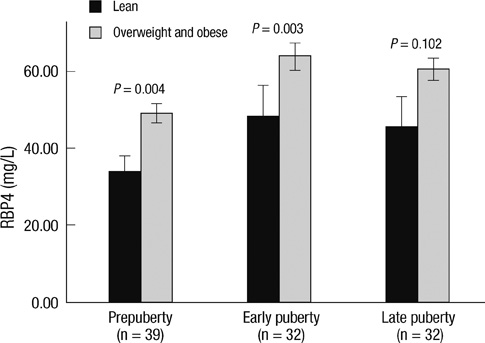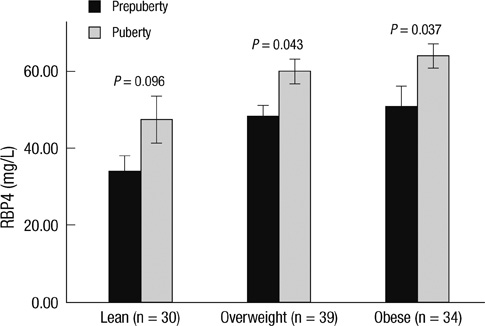J Korean Med Sci.
2011 Jun;26(6):797-802. 10.3346/jkms.2011.26.6.797.
Association of Serum Retinol Binding Protein 4 with Adiposity and Pubertal Development in Korean Children and Adolescents
- Affiliations
-
- 1Department of Pediatrics, Korea University College of Medicine, Seoul, Korea. khlee218@kumc.or.kr
- KMID: 1785967
- DOI: http://doi.org/10.3346/jkms.2011.26.6.797
Abstract
- Retinol binding protein 4 (RBP4) has been postulated to provide a new link between obesity and insulin resistance. We aimed to assess the relationship between serum RBP4 and insulin resistance by investigating serum RBP4 levels in children and adolescents according to degree of obesity and pubertal stage. A total of 103 (30 lean, 39 overweight, 34 obese) were evaluated for serum RBP4, adiponectin, insulin, glucose and lipid profiles. RBP4 levels of obese and overweight groups were higher than those of lean group. RBP4 level was higher in pubertal group than in prepubertal group. RBP4 was positively correlated with age, height, weight, body mass index (BMI), abdominal circumference, systolic blood pressure, fasting insulin, homeostatic model assessment of insulin resistance (HOMA-IR), total cholesterol and triglyceride, and inversely with adiponectin. In the multiple linear regression analysis, RBP4 was found to be independently associated with pubertal stage, BMI and triglyceride but not with HOMA-IR. In conclusion, serum RBP4 level is related with degree of adiposity and pubertal development. The association of RBP4 with insulin resistance is supposed to be secondary to the relation between RBP4 and adipose tissue in children and adolescents.
MeSH Terms
-
Adiponectin/blood
*Adiposity
Adolescent
Age Factors
Blood Glucose/analysis
Blood Pressure
Body Mass Index
Child
Cholesterol/blood
Female
Humans
Insulin/blood
Insulin Resistance
Male
Obesity/*blood/metabolism/physiopathology
Puberty/*blood/metabolism/physiology
Republic of Korea
Retinol-Binding Proteins, Plasma/*metabolism
Sex Factors
Triglycerides/blood
Waist Circumference
Figure
Reference
-
1. Mohamed-Ali V, Pinkney JH, Coppack SW. Adipose tissue as an endocrine and paracrine organ. Int J Obes Relat Metab Disord. 1998. 22:1145–1158.2. Blaner WS. Retinol-binding protein: the serum transport protein for vitamin A. Endocr Rev. 1989. 10:308–316.3. Yang Q, Graham TE, Mody N, Preitner F, Peroni OD, Zabolotny JM, Kotani K, Quadro L, Kahn BB. Serum retinol binding protein 4 contributes to insulin resistance in obesity and type 2 diabetes. Nature. 2005. 436:356–362.4. Basualdo CG, Wein EE, Basu TK. Vitamin A (retinol) status of first nation adults with non-insulin-dependent diabetes mellitus. J Am Coll Nutr. 1997. 16:39–45.5. Cho YM, Youn BS, Lee H, Lee N, Min SS, Kwak SH, Lee HK, Park KS. Plasma retinol-binding protein-4 concentrations are elevated in human subjects with impaired glucose tolerance and type 2 diabetes. Diabetes Care. 2006. 29:2457–2461.6. Yoshida A, Matsutani Y, Fukuchi Y, Saito K, Naito M. Analysis of the factors contributing to serum retinol binding protein and transthyretin levels in Japanese adults. J Atheroscler Thromb. 2006. 13:209–215.7. Munkhtulga L, Nakayama K, Utsumi N, Yanagisawa Y, Gotoh T, Omi T, Kumada M, Erdenebulgan B, Zolzaya K, Lkhagvasuren T, Iwamoto S. Identification of a regulatory SNP in the retinol binding protein 4 gene associated with type 2 diabetes in Mongolia. Hum Genet. 2007. 120:879–888.8. Graham TE, Yang Q, Bluher M, Hammarstedt A, Ciaraldi TP, Henry RR, Wason CJ, Oberbach A, Jansson PA, Smith U, Kahn BB. Retinol-binding protein 4 and insulin resistance in lean, obese, and diabetic subjects. N Engl J Med. 2006. 354:2552–2563.9. Haider DG, Schindler K, Prager G, Bohdjalian A, Luger A, Wolzt M, Ludvik B. Serum retinol-binding protein 4 is reduced after weight loss in morbidly obese subjects. J Clin Endocrinol Metab. 2007. 92:1168–1171.10. Janke J, Engeli S, Boschmann M, Adams F, Böhnke J, Luft FC, Sharma AM, Jordan J. Retinol-binding protein 4 in human obesity. Diabetes. 2006. 55:2805–2810.11. Gavi S, Stuart LM, Kelly P, Melendez MM, Mynarcik DC, Gelato MC, McNurlan MA. Retinol-binding protein 4 is associated with insulin resistance and body fat distribution in nonobese subjects without type 2 diabetes. J Clin Endocrinol Metab. 2007. 92:1886–1890.12. Balagopal P, Graham TE, Kahn BB, Altomare A, Funanage V, George D. Reduction of elevated serum retinol binding protein in obese children by lifestyle intervention: association with subclinical inflammation. J Clin Endocrinol Metab. 2007. 92:1971–1974.13. Reinehr T, Stoffel-Wagner B, Roth CL. Retinol-binding protein 4 and its relation to insulin resistance in obese children before and after weight loss. J Clin Endocrinol Metab. 2008. 93:2287–2293.14. Kanaka-Gantenbein C, Margeli A, Pervanidou P, Sakka S, Mastorakos G, Chrousos GP, Papassotiriou I. Retinol-binding protein 4 and lipocalin-2 in childhood and adolescent obesity: when children are not just "small adults". Clin Chem. 2008. 54:1176–1182.15. Park YH, Kim KW, Lee KE, Kim ES, Sohn MH, Kim KE. Clinical implications of serum retinol-binding protein 4 in asthmatic children. J Korean Med Sci. 2009. 24:1010–1014.16. Ribel-Madsen R, Friedrichsen M, Vaag A, Poulsen P. Retinol-binding protein 4 in twins: regulatory mechanisms and impact of circulating and tissue expression levels on insulin secretion and action. Diabetes. 2009. 58:54–60.17. Tanner J. Growth at adolescence. 1962. 2nd ed. Oxford, England: Blackwell Scientific Publications.18. Lee DC, Lee JW, Im JA. Association of serum retinol binding protein 4 and insulin resistance in apparently healthy adolescents. Metabolism. 2007. 56:327–331.19. Ingelsson E, Lind L. Circulating retinol-binding protein 4 and subclinical cardiovascular disease in the elderly. Diabetes Care. 2009. 32:733–735.20. Shin MJ, Kang SM, Jang Y, Lee JH, Oh J, Chung JH, Chung N. Serum retinol binding protein 4 levels are associated with serum adiponectin levels in non-diabetic, non-obese subjects with hypercholesterolemia. Clin Chim Acta. 2007. 378:227–229.21. Friebe D, Neef M, Erbs S, Dittrich K, Kratzsch J, Kovacs P, Blüher M, Kiess W, Körner A. Retinol binding protein 4 (RBP4) is primarily associated with adipose tissue mass in children. Int J Pediatr Obes. 2010. doi:10.3109/17477166.2010.491228.22. Klöting N, Graham TE, Berndt J, Kralisch S, Kovacs P, Wason CJ, Fasshauer M, Schön MR, Stumvoll M, Blüher M, Kahn BB. Serum retinol-binding protein is more highly expressed in visceral than in subcutaneous adipose tissue and is a marker of intra-abdominal fat mass. Cell Metab. 2007. 6:79–87.23. Makimura H, Wei J, Dolan-Looby SE, Ricchiuti V, Grinspoon S. Retinol-binding protein levels are increased in association with gonadotropin levels in healthy women. Metabolism. 2009. 58:479–487.24. Böttner A, Kratzsch J, Müller G, Kapellen TM, Blüher S, Keller E, Blüher M, Kiess W. Gender differences of adiponectin levels develop during the progression of puberty and are related to serum androgen levels. J Clin Endocrinol Metab. 2004. 89:4053–4061.25. Santoro N, Perrone L, Cirillo G, Brienza C, Grandone A, Cresta N, Miraglia del. Variations of retinol binding protein 4 levels are not associated with changes in insulin resistance during puberty. J Endocrinol Invest. 2009. 32:411–414.26. Erikstrup C, Mortensen OH, Pedersen BK. Retinol-binding protein 4 and insulin resistance. N Engl J Med. 2006. 355:1393–1394.27. Takashima N, Tomoike H, Iwai N. Retinol-binding protein 4 and insulin resistance. N Engl J Med. 2006. 355:1392.28. McGarry JD. Banting lecture 2001: dysregulation of fatty acid metabolism in the etiology of type 2 diabetes. Diabetes. 2002. 51:7–18.
- Full Text Links
- Actions
-
Cited
- CITED
-
- Close
- Share
- Similar articles
-
- Childhood Obesity and Pubertal Development
- Clinical Implications of Serum Retinol-Binding Protein 4 in Asthmatic Children
- Growth and Puberty in Obese Children and Implications of Body Composition
- Normative Data on Serum Levels of IGF-I, IGFBP-3 in Healthy Korean Children: Effect of Age, Sex, Height, Body Mass Index, and Pubertal Maturation on the Serum Levels
- Relation of Absolute or Relative Adiposity to Insulin Resistance, Retinol Binding Protein-4, Leptin, and Adiponectin in Type 2 Diabetes



